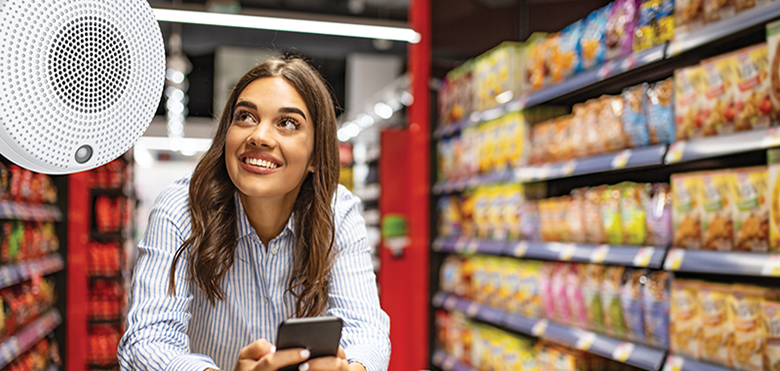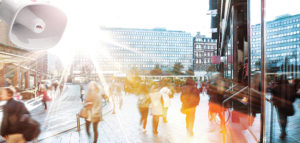How retailers can use network audio to level up in-store operations
We are all used to hearing promotions, call-outs and notifications about closing time when shopping. Speakers in stores have been helpful for decades. But what about network audio, how can retailers benefit from using those instead of traditional speaker systems? And what happens when connecting audio with video?
There are a number of ways that retailers can use audio (and video) smartly, but broadly these can be grouped into three main areas which will have a big effect. Whether to align with marketing strategies, smooth operations or support safety and security practices, audio can be used to support retailers:
1. Supporting the safety of staff and shoppers in the right way
Security is key to the retail experience, as both employees and shoppers want to feel safe in and around the store. Although when discussing safety there tends to be a focus on activity with criminal intent, it’s important to remember that health concerns remain. Even with relaxed restrictions, some shoppers and staff are still wary of crowded stores – For example, in June 2021 PwC conducted a Global Consumer Insight Pulse Survey which found that 35 per cent of consumers believed increased health and safety measures such as controlled numbers were important when shopping in physical stores.
Audio – together with video – can both reassure shoppers of the safety measures in place and assist in controlling customer occupancy so there are not too many people in the store at the same time. When the predetermined maximum number of occupants is reached, shoppers wishing to enter the store will be instructed by voice message to wait.
Retailers can also combine audio solutions with video surveillance when, for example, monitoring areas outside of stores. If there are people loitering or gathering after opening hours, for instance, alerts triggered by camera analytics can be sent to security teams and messages will be played to encourage groups or individuals to move on. Alternatively, pre-recorded messages can be played in unmonitored installations. For example, if staff mistakenly placed a pallet in front of an exit, voice messages could be used to advise employees to move the pallet to a different location to ensure that exit remains accessible.
Through these actions suspicious behavior can be addressed, ultimately leading to fewer incidents, less downtime and a reduction in security personnel needed on site, saving money and time.
Brazilian retailer Bemol recognized that it needed to address the theft of goods, which were due to failures of the existing camera and access control systems. Bemol implemented a new surveillance system across a range of premises, which alerted the security teams to intruders and provided high quality imagery for forensic investigation following an incident. Although the system worked well, the team decided to up-level the functionality by including audio speakers. This resulted in improved communication between security teams and suspicious individuals, helping to reduce theft and vandalism.
2. Minimizing shrinkage and increasing profits
In addition to ensuring the security of shoppers and staff, it’s important for retailers to reduce the risk of theft or ‘shrinkage’. Losses from shoplifting can be significant – it’s been reported that European retailers lose roughly €49bn a year from shrinkage. Solutions using audio can support in deterring theft by playing announcements and alerts when suspicious behavior is detected by video cameras. For example, if a visitor loiters in an area of the store with high value goods, a message can be played to let them know that a member of staff is on their way to assist, acting as a deterrent to shoplifting behavior.
Using the combination of video surveillance and audio can be incredibly effective. RC Willey, a large home furnishings chain in the US had seen a reduction in shrinkage after deploying cameras in stores and warehouse to track inventory and spot discrepancies. In an effort to increase profits even more, the retailer added audio speakers to the security solution, to play pre-recorded messages to intruders or vandals when they were detected by cameras. As a result of the combined implementation, RC Willey found that theft and vandalism expenses dropped from $40-$50K a year to zero at its Las Vegas distribution centre, even though the location was a hot spot for criminal activity.
3. Improving store performance and customer experience
Experiences that encourage repeat custom are directly related to the attention shoppers receive in store. If the retailer is given the time and opportunity to understand the customer’s needs, this increases the likelihood of a completed sale.
Network audio solutions can create a calming and welcoming atmosphere which encourages shoppers to browse and linger, by providing background music at the right volume and quality in various zones. Staff can get triggered alerts from camera analytics to attend to shoppers who may need assistance. At the same time, a voice message can be shared to let them know that help is on the way.
Relevant promotions and updates can be communicated using reliable, high quality audio, to help customers make a purchasing decision or alert them to deals and offers. These can be designed to be played automatically when the customer enters specific zones.
Once a shopper has selected an item, there is still a chance of a lost sale if the final part of purchase journey isn’t optimized. Long queues and waiting times can be a turn off, especially if customers are pressed for time. Alongside people-counting technology, audio can be used to instruct staff to attend to the tills, which will shorten queue lengths. Messages can be played to waiting customers to assure that more tills will be open or direct them to alternative self-checkout areas. These use cases can be addressed using an integrated audio system that is simple to operate and maintain, saving time and resources.
Following the difficulties associated with lockdown restrictions, Sweden’s first unmanned confectionary store, Crazy Candy needed to extend opening hours and reduce staff numbers and costs, while keeping customers safe and secure. The retailer implemented a solution which helped monitor customer entry and movements around the store, while using network audio to create the right atmosphere and play alerts or relevant instructions. As a result, Crazy Candy was able to safely extend store opening hours, improve customer experience and increase sales.
Multi-purpose usage of network audio systems
With Axis network audio solutions, customers get a multipurpose system that can be used for security call-outs, safety reminders, commercial activities and promotions. You can also use the system to play background music. This means that security call-outs, public communications systems and daily business announcements can be managed and controlled within the same system.
As customer and market needs change, retailers will need to adapt. In doing so, it is important to have technology in place which allows retailers to use network audio to enhance capabilities, improve security measures and enhance the in-store experience. Implementing a system that connects to the standard network and is based on open standards enables retailers to integrate easily with other systems, giving them the flexibility and scalability that they need.
With time, the use cases for audio will only increase as store layouts and facilities become more complex to meet customer demands. By investing in the right audio solution, retailers will be able to reap the rewards now and in future.
Click here to find out more about Axis’ network audio solutions for retail.


